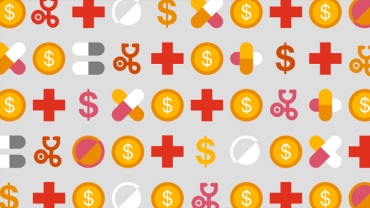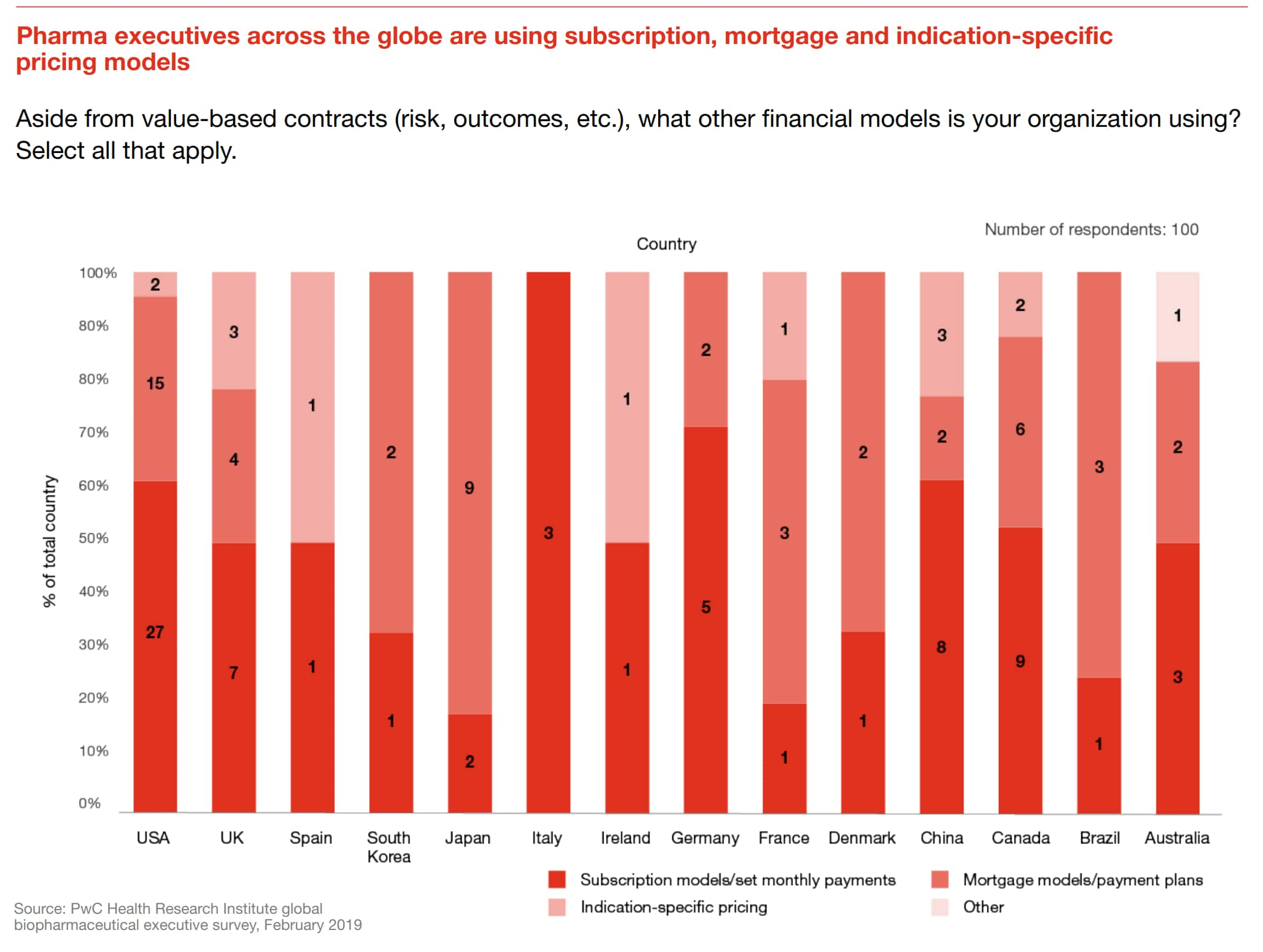
Pricing models for drugs have become more segmented and nuanced to reflect unique product characteristics, competitive dynamics and patient needs. As biopharmaceutical companies have experimented with different financial arrangements for different product types, six important models have emerged: financial risk-based contracts, health outcomes contracts, mortgage models, subscription or Netflix models, indication-specific pricing and volume-based purchasing.
1. Financial risk-based contracts
Along with health outcomes contracts, these are the two primary types of value-based contracts that are designed to tie prices to how a drug performs in the real world, as opposed to prices based solely on data and evidence collected during the highly controlled clinical trial process. New technology for monitoring patients and gathering health data has accelerated the use of value-based contracting and other innovative payment models, and has helped to improve patient access to therapy. However, data sharing challenges and operational hurdles persist.
Of the seven biopharmaceutical CEOs who testified at a Senate Finance Committee hearing in February, six argued in their written statements for expanding the use of value-based contracts. Four of the five pharmacy benefits manager (PBM) executives testifying before the same committee in April argued in favor of value-based contracts in their written statements.
While certainly not a panacea for pricing challenges, value-based contracts, volume-based pricing and other novel financial models are helping patients access prescription medications. An executive at a top 20 biopharmaceutical company told HRI that her company has more than 40 value-based arrangements across therapeutic areas, including oncology, cardiovascular, renal and metabolism and respiratory.
In 2017, HRI conducted a survey of US biopharmaceutical executives to better understand the prevalence of value-based contracts, including contracts tied to patient clinical outcomes, economic outcomes, or both. Only 25 percent of surveyed US executives in 2017 had participated in a value-based contract. In 2019, the number of US executives using value-based contracts increased to 57 percent, a 32 percentage point jump in two years’ time.
In Europe, single-payer health systems and managed entry agreements pushed drugmakers to participate in risk-based or outcomes-based contracts several years ago, and those practices are being adopted in other geographies, especially for innovative specialty drugs and orphan products.
Financial risk-based contracts are one of the value-based models companies are using to make products more competitive in the market. These contracts involve full or partial reimbursement to the purchaser if certain predetermined financial outcomes are not met. Financial outcomes could include successfully treating a patient at a lower cost than a competing therapy, for example.
Contracts focused on providing financial savings can help mitigate purchaser risks associated with high-cost therapies, particularly when there are similar, competing therapies available. Organizations with products in competitive segments of expensive therapeutic areas, such as oncology, cardiology or rheumatoid arthritis, for example, may be able to improve market access and product uptake by offering a financial risk-based contract. In one example, a university medical center entered a financial risk-based contract for a cardiovascular drug that requires patients receive the product at a $10 copay for a 30-day supply (instead of around $40). The contract includes an outcomes component tied to hospitalization for a second heart attack.
Biosimilars, too, are a natural fit for financial risk-based contracts because they are substituted for a more expensive branded biologic drug and could be assessed against it.
2. Health outcomes-based contracts
Like financial risk-based contracts, health outcome-based contracts offer full or partial reimbursement to purchasers if patients don’t respond to therapy, or don’t reach a targeted health outcome. Examples of health outcome measures include blood glucose control in diabetes—measured by HbA1c blood tests—or a reduction in the number of asthma attacks associated with product use, for example.
Measuring health outcomes has become more reliable as insurers have gotten more sophisticated in combining clinical electronic health record (EHR) data with prescription claims data. However, many disease areas don’t have a strict biological outcome that can readily serve as an assessment metric for drug performance.
Additionally, patient behavior, such as non-adherence to a treatment plan, can lead to poor outcomes unrelated to a drug’s performance. Connected digital devices and digital therapeutics may help measure adherence rates and create new contracting opportunities through the data they generate. Specialty products in the primary care market segment, such as multiple sclerosis, diabetes or chronic obstructive pulmonary disease (COPD) are good candidates for exploring health outcomes-based contracts. Manufacturers marketing curative therapies for hepatitis C have also entered into such contracts, offering refunds for patients who aren’t cured after using the therapy.
3. A mortgage model
This model for purchasing drugs offers the benefit of allowing purchasers to spread the cost of an expensive therapy over a period of time, as opposed to requiring the total payment upfront. Mortgage models can reduce the sticker shock attached to high-priced products and promote better affordability for patients. Products that aren’t facing direct competition, such as new immunotherapy products for oncology, orphan drugs targeting rare diseases, or emerging gene and cell therapies, are all good candidates for the mortgage model. Fifty percent of the executives surveyed by HRI said they are using a mortgage model.

4. The subscription or Netflix model
The novel approach offers an “all you can treat” arrangement for purchasing drugs. Pioneered in Australia for hepatitis C products, this model lets purchasers pay a set amount for unlimited patient access to specific products for a set period of time. In the US, state regulators and public health plans in Louisiana and Washington are moving forward with subscription models for hepatitis C patients. In April, the Washington State Healthcare Authority signed an agreement for hepatitis C products, with a goal to “eliminate the hepatitis C virus in the state of Washington by 2030.”
Subscription models may become useful for other curative therapies beyond hepatitis C, such as gene and cell therapies, because they promote patient access by removing benefit design restrictions. In a speech on harnessing the curative potential of genomic technologies, former FDA Commissioner Scott Gottlieb said, “Innovative payment vehicles for curative therapies can accelerate patient access, and lower long-term societal costs.”
There is evidence that new financial models for curative therapies and other high-cost medications are moving forward and increasing in number. In June 2019, a prominent insulin manufacturer will begin offering diabetes patients a flat price of $99 per month for up to 10 boxes of insulin pens or 10 milliliter vials. Seventy percent of executives surveyed by HRI said they are using a subscription model for at least one of their products. Manufacturers considering subscription models should make sure the patient population getting access is clearly defined, as treatment populations may fluctuate unexpectedly.
5. Indication-specific pricing
This is a model used for products approved to treat more than one type of disease. In this model, a product’s price is based on the indication or therapeutic area it is prescribed to treat. Products indicated for multiple diseases are often more effective in treating one disease compared with another. As such, indication-specific pricing contracts pay more for a drug when it’s highly effective in treating one disease, but pays less for indications where the drug is less effective.
Insurers may also place one product indication in a preferred tier for patients, and place the same drug in a less preferred tier, or forego coverage altogether, for a different indication. The increased use of electronic health records by physicians has led to a significant increase in e-prescribing, which in turn has made it easier for insurers and PBMs to identify which disease a drug is prescribed to treat. Indication-specific pricing models have been implemented by large PBMs for oncology and autoimmune products, respectively.
Monoclonal antibodies, for example, often receive approval for multiple indications, and have helped to push the use of indication-specific pricing to major drug markets across the globe. The FDA has approved over 80 monoclonal antibodies for use, spanning treatment areas including cancer, asthma, macular degeneration, arthritis and Crohn’s disease, among others. In Europe, indication-specific pricing exists but isn’t yet common in the majority of markets.
6. Volume-based pricing
This option continues to be useful in circumstances where large quantities of a drug are needed, especially for preventive therapies, such as flu shots. Volume-based pricing is attractive to government payers that provide free vaccines to citizens, for example.
During a Senate Health Committee hearing in March, Sen. Patty Murray, D-Wash., noted that the measles, mumps and rubella vaccine costs just $20 a dose, compared to the $1 million her home state has spent combating outbreaks. Generics may also be purchased in volume-based deals and antibiotic stewardship programs may also benefit from such arrangements. Volume-based pricing models are less relevant for high-cost specialty drugs or biologics, where the use of value-based contracts is on the rise, according to HRI survey data.
Data is the currency that defines product value. To successfully price and commercialize products, biopharmaceutical companies will need to become more sophisticated in their use of data to support customer negotiations and new financial models; to navigate different value assessment frameworks in different global markets; and ultimately, to tell the story of individual products to different customers.
For citations, implications and insights, please read our full report, Creating a stable drug pricing strategy in an unstable global market.
For more of HRI’s insights and content, visit our Regulatory Center and report library.








